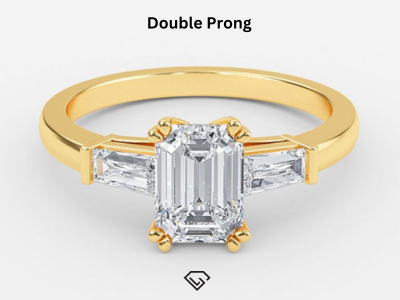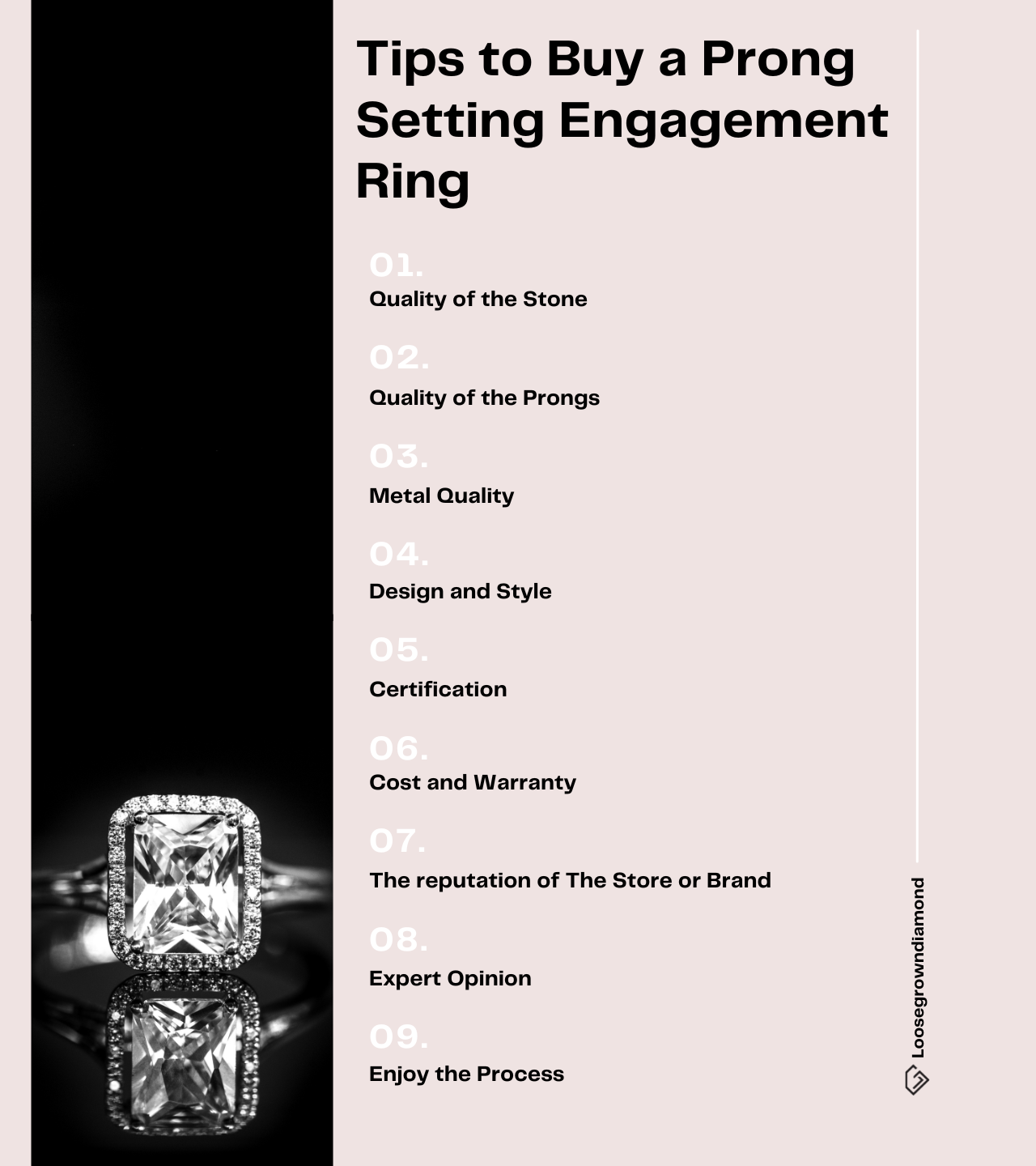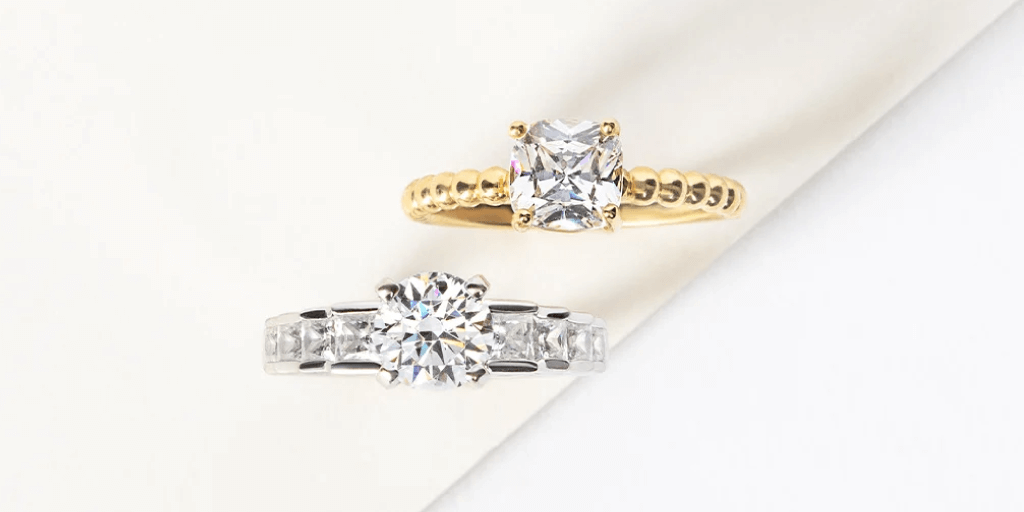The Glitter of Prong Setting: A Comprehensive Guide
One arrangement should be made in such a way that they truly make a statement. Choosing the ideal ring requires more than just selecting a stone and a metal. Although people frequently use them nowadays, prong settings are one of the most stunning methods to show off the perfect stone in all its beauty. Continue reading to learn more about prong sets and how they may improve your next ring.
Although prong settings have been around since the 19th century, Tiffany & Co.’s innovations are what made them famous. The Tiffany four-prong setting started in 1886, indicating that the stones were floating above the wearer’s finger rather than primarily contained in the metal.
For jewelry where the stone is the focal point, such as engagement and wedding rings, prong settings revolutionized the industry. Furthermore, despite their apparent simplicity, prong sets were and still are technological wonders.
What Is a Prong Setting?
A prong setting is a piece of jewelry used to secure a gemstone or diamond. As the name suggests, prong settings use tiny prongs to ensure a cut stone. There is much more stone on view than in any previous setting because they keep the stone in place with four or more thin metal prongs with perfectly etched grooves.

It includes bending multiple metal prongs (often four or six) over the stone and pressing them down to secure it. These prongs, typically found in the corners off the stone, are intended to raise it off the metal base so that light can travel through and enhance the stone’s appearance of brilliance and brightness.
Pros and Cons of Prong Setting

Pros of Prong Setting:
- The gemstone seems brighter and more brilliant thanks to the prong setting’s optimal light transmission.
- It is flexible since you can alter the prongs to fit various stone shapes.
- The prongs are made to be delicate and subtle, which makes the stone the focal point of the piece.
- You can replace the prongs if they get worn off or harmed.
Cons of Prong Setting:
- Prongs can be prone to bending or breaking, which can cause the stone to fall out.
- Prongs may become bent or broken if they catch on anything like clothing or other materials.
- Prongs can be more challenging to clean and maintain because you must check them to ensure they are secured routinely.
- Prongs are more prone to snagging and damage than other settings.
- Prongs should not be worn by those who mistreat their jewelry or by those who lead active lifestyles.
Types of Prong Setting?

Claw Prong
The claw prong, also known as a pointed prong, extends more over the diamond’s surface than a round prong but covers less of the diamond’s contour. The petite claw, a scaled-down form, and the double claw are variations of the claw prong.

It is similar to the traditional four- or six-prong setting, but the claws are more visible and can add an exciting design element to the piece.
Tab Prong
The square or “tab” prong style is another distinctive appearance. A squared-off prong, albeit less common than a round or claw, can provide a unique touch to the correct ring design. This type of prong setting involves metal tabs bent over the stone to hold it in place. The tabs are more comprehensive and can add a different design element to the piece.
Double Prong

Compared to a single solid prong, a double prong setting provides the impression that the prongs are slimmer. Double-prong setting diamond holds very securely and is ideal for larger diamonds since it increases safety without appearing bulky. They can be rounded or pointed.
Tulip Prong

The tulip prong setting secures a diamond in place by creating a basket in the style of a flower bulb and extending the prongs upward to resemble the petals of a flower. Since there is more metal surrounding the stone in this design, less obvious brilliance might happen.
A tulip setting gives a distinctive and fashionable twist to the traditional engagement ring, even though it encloses the diamond in more metal and reduces the amount of light that can shine through the stone. Additionally, it increases the prong set diamond’s safety and security.
Tulip prongs come in two different sizes: four and six. A four-prong tulip works best with square or rectangular diamonds, like the princess, cushion, or emerald cut. A six-prong tulip works best with diamonds that are round or oval.
Button Prong
Button prongs are the most popular type of prong finishing; they encircle a small portion of the diamond’s surface and, when seen from above, resemble small dots or buttons, hence their name.
The prongs finish with a rounded head to securely retain the diamond and reach just over the diamond’s girdle. The button-shaped prongs can add a sleek and modern look to the ring.
People often use this type of prong setting to set round-shaped diamonds, creating a simple and elegant look. The button-shaped prongs can also better protect the diamond prong settings and make the diamond appear more prominent.
The button prongs are low-profile, which means they will sit closer to the finger, making the ring more comfortable to wear. It also allows the ring to stack with other bands and rings.
Round Prong

A round prong setting is a type of prong setting where the shape of the prongs is like a round bead. The round shape of the prongs can add a different design element to the piece. The round prongs can add a smooth and sleek look to the ring.
This type of diamond prong setting is often used to set round-shaped diamonds and creates a simple and elegant look. The round prongs can also better protect the diamond and make it appear larger.
V Prong

The v-prong is shaped exactly like it sounds, wrapping around the diamond’s point. A pear, princess, or marquise cut diamond’s weak points are well-protected by this particular prong. The design is less intrusive because it blends well with the diamond’s natural shape.
Pointed Claw Prong
A pointed-claw prong setting is a variation of the traditional one, where you can taper the claws to a point at the end instead of being rounded. The claws’ pointed shape allows maximum light to enter the stone and provides a more modern and sleek look.
This setting is often used in contemporary jewelry designs and is particularly popular in engagement rings. The pointed claws can make the stone appear more brilliant and enhance the diamond prong settings in the ring.
The pointed shape can be more delicate than the traditional claw prong, making it more suitable for active people.
Shared Prong
People generally use shared prongs when setting diamond melee (smaller diamonds). To prevent using too much metal and affecting the exquisite shine of the setting, the diamonds are held in place by shared prongs.
A shared prong setting, also known as a pave setting, is a type of prong setting where multiple stones are held in place by minimal prongs. You can also call this a micro-pave setting, as the prongs are tiny and shared between several diamonds.
This type of setting allows a large amount of light to reach the diamonds, making them appear brighter and more brilliant. It also creates a more continuous and elegant look as it eliminates the appearance of metal between the stones.
A shared prong setting is a popular choice for eternity bands, engagement rings, and other types of prongs. It is also a good option for those who want a more delicate and dainty look.
Four vs Six Prongs?
As already mentioned, four- and six-prong settings are the most common options for prong sets. Making this decision requires considering several different angles. First, having fewer prongs allows more light to shine on the diamond prong settings and makes them more visible.

Six prongs are theoretically more secure, but at the same time, The vital thing to remember is that a four-prong mounting is made symmetrically to guarantee that the diamond won’t come out in the unlikely event that you lose a prong completely.
Six prongs may need to be more balanced from a durability perspective. Six prongs make more sense from both perspectives for larger diamonds.
For an engagement ring, the choice between a four-prong setting and a six-prong setting comes down to personal preference and the shape of the diamond.
Four Prong Setting:
- The four-prong setting is the most traditional and classic type of prong setting.
- It is the most common type of setting used in engagement rings.
- Four prongs provide a simple and elegant look, making it a popular choice for those who want a classic look.
- It also allows more light to pass through the diamond, making it appear brighter and more brilliant.
Six Prong Setting:
- The six-prong setting is similar to the four-prong setting but has six prongs instead of four.
- The extra prongs give the stone more security and stability, making it a great choice for people who want a more secure setting.
- This type of setting can make the diamond look more extensive, and it can also protect the diamond better.
- The six-prong setting can also create a more complex and detailed look.
To conclude, the four-prong setting is more traditional and elegant, while the six-prong set provides more security and stability. The choice between the two is ultimately a matter of personal preference and the specific characteristics of the diamond.
Should You Buy a Prong Setting Engagement Ring?
Prong-setting engagement rings are an excellent option for those who want to showcase their diamond or gemstone in a simple, elegant, and timeless design. The prongs lift the stone off the metal base, allowing maximum light to pass through and making the stone appear brighter and more brilliant. This type of setting is also versatile, as it can be adjusted to fit differently shaped stones.

However, it is worth noting that prongs can be prone to bending or breaking, which can cause the stone to fall out. Also, prongs can be snagged or damaged more quickly than other types of prongs. For this reason, prong-setting engagement rings may not be the best choice for people who are rough with their jewelry or have an active lifestyle.
Before buying a prong setting engagement ring, consider your lifestyle and how you will be wearing the ring. If you are rough with your jewelry and have an active lifestyle, consider other prongs, such as a bezel set or tension setting.
But if you prefer the classic, elegant look and are willing to take the necessary care for your ring, then a prong setting engagement ring can be a great option.
Tips to Buy a Prong Setting Engagement Ring
When buying a prong setting engagement ring, it is essential to consider several factors to ensure that you get a high-quality piece that will last a lifetime.

Here are some tips that you should keep in mind when buying a prong-set engagement ring:
-
Quality of the Stone:
- Always check the stone’s quality before purchasing a ring.
- The most costly and stunning diamonds will have excellent color and clarity grades, so keep an eye out for these.
- Keep away from purchasing diamonds with obvious imperfections or inclusions since these may lessen the stone’s appeal.
-
Quality of the Prongs:
- Inspect the prongs to ensure that they are solid and well-made.
- Keep away from purchasing prongs on rings with bent or damaged prongs because they can lead to the stone falling out.
-
Metal Quality:
- Ensure that the ring is made of high-quality metal, such as platinum, palladium, 14K, or 18K gold.
- Refrain from purchasing rings made of inferior metals because they won’t last as long.
-
Design and Style:
- When selecting a prong set, take the ring’s design and style into account.
- Also, consider your preferences and way of life when selecting a design you’ll enjoy and feel at ease wearing.
-
Certification:
- Always look into the diamond’s certification; GIA is the best gemology as it guarantees that the diamond is untreated and natural.
-
Cost and Warranty
- Before making a purchase, compare the costs and qualities of several prong setting engagement rings.
- Always look into the warranty.
-
The Reputation of The Store or Brand
- Before making a purchase, always check the brand or reputation of the retailer.
- Read customer reviews and evaluate the after-sales and customer service.
-
Expert Opinion
- Ask a respectable jeweler for professional advice if you have questions about the ring’s quality, design, or anything else linked to it.
-
Enjoy the Process
- Purchasing a prong engagement ring is a significant and joyous occasion, so take your time and enjoy the search for the ideal ring for your partner.
Conclusion
In conclusion, a prong set engagement ring can be perfect if you want a classic, sophisticated, and adaptable style to highlight your diamond or gemstone. Before making a purchase, it’s crucial to think about the ring’s strength, maintenance requirements, and compatibility with your lifestyle.
Among the different types of prongs for rings, always check the metal, prongs, and stone quality, and if in doubt, seek professional advice. The most crucial thing is to pick a ring you adore and will be content to wear for the rest of your life.
Frequently Asked Questions (FAQs)
Is Prong Setting Good?
A standard and attractive method of displaying a gemstone or diamond in jewelry is through a prong set. The gem seems brighter and more brilliant because the maximum amount of light can enter through it. It is also adaptable because you can accommodate various stone shapes.
Before making a purchase, it’s crucial to think about the ring’s strength, maintenance requirements, and compatibility with your lifestyle.
Are Prong Settings Safe?
If prong settings are well-made and properly maintained, they can be safe. Avoid purchasing rings with bent or damaged prongs since these might cause the stone to fall out.
Instead, ensure the prongs are sturdy and well-made. It’s also crucial to get the ring routinely checked by a jeweler to ensure the prongs are solid.
Do Prongs Damage Diamonds?
If prongs are not adequately cared for or if you repeatedly knock or bump the ring, they may endanger diamonds. A jeweler needs to look at the ring regularly to make sure that the prongs are secure and to make any repairs that might be needed.
How Long Do Ring Prongs Last?
The metal’s quality, the craftsmanship, how well the ring is cared for, and other factors influence the durability of ring prongs.
With the proper upkeep and care, prongs can survive for many years, but it’s crucial to have the ring checked by a jeweler regularly to make sure the prongs are secure and to perform any required repairs. Generally, we advise that you get your ring examined at least once a year.








